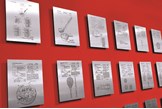Behind the scenes at Wilson’s Innovation Centre
Published: Last updated:
Wilson are going from strength to strength at the moment, thanks to a consistent stream of top quality products and tour pro validation. We speak to the men behind the new designs.
The two men leading R&D operations for Wilson golf clubs and balls – Jon Pegande and Frank Simonutti – have more than 50 years of experience with the brand and its pioneering products between them.
They work with teams at the purpose-built Wilson Innovation Centre in Chicago, which opened in 2007. It explores new design concepts and materials to be used across many different sports served by the famous brand. This gives the two golf innovators unrivalled access to extensive knowledge and advanced technology that can speed up development of exciting new golfing products.
At the Center, they can design and produce prototypes that streamline the entire development process. What each of them also have in common is the ambition to help golfers at all levels improve their game with the best equipment possible at affordable prices.
Here Jon and Frank answer some questions about their work, interaction with Tour players and how they can still look to the future, even during these uncertain times.

How do you think the current situation will affect golf R&D and the introduction of future new lines?
JP: Product development is still progressing within Wilson, with some notable challenges relating to our ability to prototype and test products. At this point, there have not been gross changes in plans for product launches, but that may change.
FS: Our current golf ball development was well along the path before the Coronavirus situation and our upcoming lines are on schedule for launch.
Does this period present an opportunity to test more prototypes among brand ambassadors while the Tours are on hold?
JP: We’ve maintained contact with our Tour players and brand ambassadors during recent months. Our current challenge relates to access to golf courses, travel and maintaining the social distancing. Apart from that, we’re taking this time to create prototypes and are ready to get feedback from our players as soon as courses open, and the Tour starts to resume some semblance of normal operations.
FS: Not really, as a large part of the testing with brand ambassadors in the development phase is to be present to ‘see what they are seeing’ and get first-hand observations to confirm positives and see what improvements to the product are necessary. The current situation precludes this part of the development process.
What part do Tour stars play now in providing feedback on concepts and new product designs?
JP: We count on information from all of our players, as it relates to commentary on current products, as well as feedback on new prototypes and projects.
FS: Tour player and Advisory Staff player testing is vital to testing of balls made for the best players.

What is the average timeframe for new product development and taking products to market?
JP: We’re always working on technology and design factors that go into our products. Once we kick off a product for launch, we usually plan on about 18 months to create and refine, before launching to the consumer.
FS: It depends upon the product. Improvements to previous products (such as new Duo Soft + compared to Dx2 Soft) usually takes between 12-15 months. New concept balls, such as our upcoming introductions, can be up to two years.
Has this length of time shortened or lengthened in recent years… and if so, why?
JP: Our ability to prototype and visualize product has really improved in recent years. This has reduced lead times, but we have also increased the amount of features and concepts that we’d like to consider. The overall effect keeps the timing about the same.
FS: The timeline really doesn’t change, as new materials and ideas are being pursued all of the time and the amount of testing needed to bring a ball to market is relatively constant. If we are really lucky in the development process, it can be shorter. But, if we have setbacks in trying to achieve our goals it could be longer.
To what extent does the Wilson heritage in irons and balls help to move the dial for future innovation?
JP: From a product perspective, our goal is to create products that perform for today’s players. But, it’s nice to have a history to pull from to make sure we can deliver on those goals.
FS: Our heritage dictates that we create and provide the best performance balls for every level of player. Different players require different products. For example, a Urethane ball ideal for a Tour player would not be ideal for an average player who has trouble hitting fairways due to 30+% higher spin off the Driver. This is no different than Tour players playing blades and average players playing game improvement clubs. We strive to make the game enjoyable for all players and hope that as they improve they can move from game improvement product to more performance products.

Has the recent USGA/R&A driving distance report given you more scope or less?
JP: We’ll take in information from all sources, but the report has had very little impact on our current development. Our goals have always been to produce the best possible products that conform to the rules of golf and meet the needs of consumers.
FS: I don’t see this report as having much impact on our development scope at this time. We’ll continue to develop the best balls for every type of player. If the conformance rule changes, then we’ll adjust accordingly.
What do you regard as the brand’s biggest product story during your two decades and more at Wilson?
JP: The Fat Shaft iron concept was a very memorable product that took a unique concept and delivered a very high level of performance. I have really enjoyed the product range around Padraig Harrington during his run of Major wins. Fresh in my memory though, are the Staff Model Blades that Gary Woodland enjoyed such success with, especially wining at the US Open in 2019 – the 62nd Major victory with Wilson irons!
FS: We began with softer feel in 1997 (Staff Titanium Spin) and followed by SmartCore, Dx2 Soft/Dx3 Soft. In my opinion, the biggest product story has been the introduction of Wilson Staff DUO/Dx2 Soft ball in 2011. This ball changed the perception of soft and set a soft ball trend followed by several rival brands. It truly changed the 2-piece golf ball category. I’m also feeling very positive about product stories for upcoming products over the next year and more.




